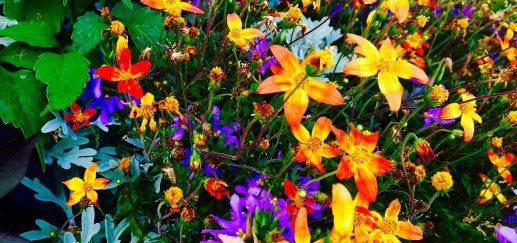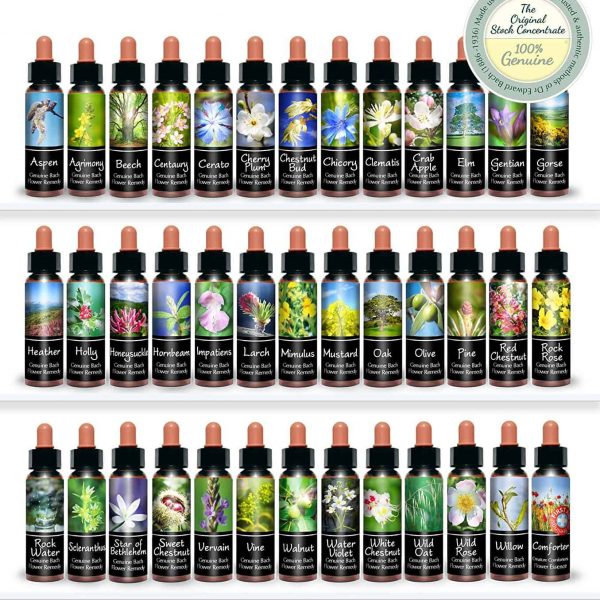
Flower Essence - Bach
What are flower essences?
Flower essences are herbal infusions or decoctions, made from the flowering part of the plant, which uniquely address emotional and mental aspects of wellness. The first 38 flower remedies were formulated by a British physician, Dr. Edward Bach, in the 1930’s, although new remedies from other plant species are now available.
How do flower essences work?
To understand how flower essences work requires a recognition that the human being is more than a physical body, but also incorporates a “body” of life energy, a “body” of sensitivity and feelings, and a spiritual essence or Self. Flower essences are energetic imprints of the life force of plants which interact with these subtle bodies of the human being, and evoke specific qualities within us. We can say that they work in a similar way to inspirational music or art, which carry meaning through the vehicle of sound or light, while the flower essences work through the medium of water.
Modern physics has known for nearly a century that matter and consciousness are intertwined. However, medical science still generally works with a nineteenth century model of the human being as a mechanism in a world of machines. We expect that in the coming century medical science will develop ways of studying the impact of consciousness on health, and we will learn more about the ways in which flower essences work. However, empirical research, which consists of the collection of case studies and practitioner reports, will remain the primary source of knowledge about how flower essences work.
Flower Essence Therapy helps us to deal more constructively with the negative behavior patterns of human nature such as jealousy, impatience, inability to say no, timidity, and inappropriate guilt—patterns that are seen, as a deeper cause of physical illness. Flower Essence may also be used to support professional psychological or medical treatment—but cannot take their place.
People experience only two states of being: Love or Fear. Love and fear cannot share the same inner space at the same time. These two states influence everything about us—our bodies, health, relationships, self-confidence, our awareness of spirit, literally everything. To live in a state of Love is optimal; the journey getting there may often look daunting, yet at the same time enlightening.
By better understanding and correcting the “mental errors” underlying our negative behavior patterns, we can reconnect with our own true nature. With the help of Flower Essence can assist us to regain access to our spiritual healing forces, which strengthen our immune system and support our overall health.

List and Indications of The Bach Flower Remedies
Type and mood Remedies

For very practical reasons, Dr. Bach never made a definitive list of remedies that reflect a Personality type. Working with people he gained experience and realized, like all of us who do similar work, where people are concerned anything is possible and that there are always exceptions. A person would always appear who did not fit the specified profile.
The Seven Groups of Remedies
- For Those Who Suffer from Fear
- For Those Who Suffer from Uncertainty
- For Those Who Have Insufficient Interest in Their Present Circumstances
- For Loneliness
- For Oversensitivity to Influence And Ideas
- For Despondency or Despair
- For the Over-care For Welfare of Others
List Of The Remedies And Their Uses
- Aspen — for fear and anxiety of an unknown origin
- Agrimony — for inner suffering and anguish hidden by a smiling or brave face
- Beech — for intolerance towards diversity in others (appearance, behavior, attitudes); enables us to acquire the skill to accept something or someone we neither like nor can change, with serenity
- Centaury — for those who do not know how to say „No“
- Cerato — for those who are not confident in their assessment or decision
- Cherry Plum — for loss of self-control and for fear they could hurt themselves or others;
- Chestnut Bud — unable to understand what causes those bad results or consequences; tendency to repeat errors; the inability to learn from experience
- Chicory — for selfish, possessive, domineering people in relation with closest to them
- Clematis — for dreamers, those who escapes reality by living in their ideas and future
- Crab Apple — for those who are dissatisfied with their appearance; obsessed with order and cleanliness, for cleansing the body and mind
- Elm — for an acute crisis of confidence; when bending under additional duties and/or increased level of responsibility with feeling that it goes beyond one
- Gentian — for discouragement and despondency after failure and before the next step
- Gorse — for hopelessness and pessimism
- Heather — for people obsessed with themselves, self-centered, narcissistic
- Holly — aggression towards others, hatred, jealousy, suspicion, malice, anger
- Honeysuckle — for those who live in the past, mourning for times past, nostalgia
- Hornbeam — for individuals stuck in dull, one-sided routine that results in intellectual weariness and exhaustion
- Impatiens — for impatient, hasty people
- Larch — for lack of self confidence; inferiority complex
- Mimulus — for everyday, common fears and anxieties, when a person knows what they are afraid of; also for shyness and timidity
- Mustard — for sudden depression and dark moods, with no apparent reason in the circumstances where attack occurs
- Oak — for strong, capable people struggling to overcome the limits of their strength
- Olive — for fatigue after exertion
- Pine — for excessive responsibility and tendency to feel guilty
- Red Chestnut — for anxiety, fear and worry that something bad could happen to a loved one or someone close
- Rock Rose — for terror and extreme fear and panic attacks
- Rock Water — for excessive self-control and mental rigidity; perfectionist
- Scleranthus — for inabilities to choose between alternatives, indecision
- Star of Bethlehem — for shock and grief after a personal loss or trauma
- Sweet Chestnut — for „a broken heart“, despair, when there is no escape
- Vervain — for idealists, overpowered by their excessive enthusiasm, over-sensitive to the injustice in the world; always ready to „swim against the tide“, „to right wrongs“
- Vine — for dominant people who tend to rule others with an „iron fist“
- Walnut — for protection from change and outside influences; for optimum adaptation
- Water Violet — for withdrawn, self-sufficient people who may seem proud and even arrogant; incapable to have intimacy and keep autonomy in the same time
- White Chestnut — for concern; haunting thoughts that we would be happy to be rid of
- Wild Oat — for uncertainty in the meaning of one’s existence, lack of overall direction
- Wild Rose — for laziness, resignation for everything that is happening, apathy
- Willow — for self-pity, offensiveness and placing blame on others
- Rescue Remedy or Comforter — Emergency Formula for acute stress
